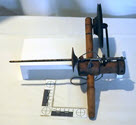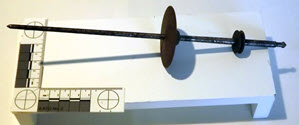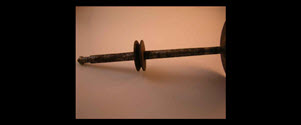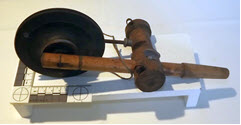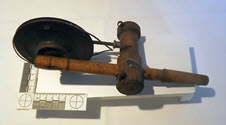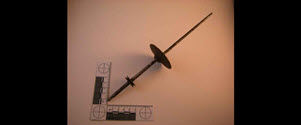Wheel, Spinning, Parts
| Nom de l'objet : | Wheel, Spinning, Parts |
| Type de l'objet : | Minor's Head Spindle |
| Catégorie de l'objet : | Textileworking T&E Tools & Equipment for material |
| Matériaux : | Wood and metal |
| Numéro d'accession : | 98.27.01a,b |
| Date de début de production : | 1800-01-01 |
| Date de fin de production : | 1998-12-31 |
| Description : | a) Minors Head, A turned wooden bar, with a stem below, and two adjustable vertical posts, upon which is mounted a large grooved wooden disc called an accelerating head. The accelerating head speeds up the rotation of the spindle (pointed rod used for collecting yarn). b) A pointed metal spindle used for collecting twisted yarn. This spindle would have been attached to a large grooved wooden disc called an accelerating head. |
| Fonctions : | a) This object is a Minors Head for a spinning wheel. The Great or Walking spinning wheel consists of a very large flat-rimmed drive wheel which is turned by the spinners right hand. This would have been connected to a pointed spindle, by a loop of cord. The difference in diameters of the drive wheel and the small pulley on the spindle, causes the spindle to rotate as much as a hundred-fold faster than the drive wheel. In 1803 and 1810, Amos Miner, (also spelled Minor), a settler in upstate New York patented a mechanism consisting of an additional pair of pulleys mounted above the spindle pulley, which more than doubled the speed of rotation of the spindle with every turn of the driving wheel. This increased the speed of rotation imparting more twist to the yarn with less effort, and proved to be crucial in the spinning of the long-staple wool of the Merino sheep, which were just being introduced into New England and New York at this time. Minors patent gave him the exclusive right to manufacture these accelerated spinning heads, but when the patent expired in 1824, Benjamin Pierce in Chesterfield, New Hampshire, followed in rapid succession by a small number of other manufacturers in this small New England town, took over the market, manufacturing as many as 30,000 heads a year. These heads were sold by merchants as replacements for common spindle heads which were used across North America. There would have been two drive bands (loops of cord) used to power this wheel. The accelerating head consists of two disks or pulleys, one smaller and the other larger. The spindle would have been mounted on the accelerating head with leather bearings. The bearings on this head have deteriorated, and the spindle is now detached from the head. b) This spindle is associated with a Minors Head for a spinning wheel. The Great or Walking spinning wheel consists of a very large flat-rimmed drive wheel which is turned by the spinners right hand. This would have been connected to a pointed spindle, by a loop of cord. The difference in diameters of the drive wheel and the small pulley on the spindle, causes the spindle to rotate as much as a hundred-fold faster than the drive wheel. In 1803 and 1810, Amos Miner, (also spelled Minor), a settler in upstate New York patented a mechanism consisting of an additional pair of pulleys mounted above the spindle pulley, which more than doubled the speed of rotation of the spindle with every turn of the driving wheel. This increased the speed of rotation imparting more twist to the yarn with less effort, and proved to be crucial in the spinning of the long-staple wool of the Merino sheep, which were just being introduced into New England and New York at this time. Miners patent gave him the exclusive right to manufacture these accelerated spinning heads, but when the patent expired in 1824, Benjamin Pierce in Chesterfield, New Hampshire, followed in rapid succession by a small number of other manufacturers in this small New England town, took over the market, manufacturing as many as 30,000 heads a year. These heads were sold by merchants as replacements for common spindle heads which were used across North America. |
| Établissement : |
Fort Point Museum
 Facebook-Fort Point Museum Facebook-Fort Point Museum
 Twitter-Fort Point Museum Twitter-Fort Point Museum
|
| Ville de l'établissement : | LaHave |
| Province de l'établissement : | Nova Scotia |
Coordonnées de cette page web
-
Pour proposer des corrections ou des mises à jour sur cette page, veuillez contacter directement le Réseau canadien d’information sur le patrimoine (RCIP).
